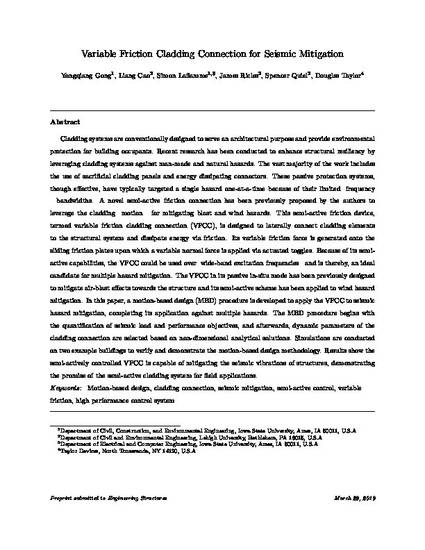
Cladding systems are conventionally designed to serve an architectural purpose and provide environmental protection for building occupants. Recent research has been conducted to enhance structural resiliency by leveraging cladding systems against man-made and natural hazards. The vast majority of the work includes the use of sacrificial cladding panels and energy dissipating connectors. These passive protection systems, though effective, have typically targeted a single hazard one-at-a-time because of their limited frequency bandwidths. A novel semi-active friction connection has been previously proposed by the authors to leverage the cladding motion for mitigating blast and wind hazards. This semi-active friction device, termed variable friction cladding connection (VFCC), is designed to laterally connect cladding elements to the structural system and dissipate energy via friction. Its variable friction force is generated onto the sliding friction plates upon which a variable normal force is applied via actuated toggles. Because of its semi-active capabilities, the VFCC could be used over wide-band excitation frequencies and is thereby, an ideal candidate for multiple hazard mitigation. The VFCC in its passive in situ mode has been previously designed to mitigate air-blast effects towards the structure and its semi-active scheme has been applied to wind hazard mitigation. In this paper, a motion-based design (MBD) procedure is developed to apply the VFCC to seismic hazard mitigation, completing its application against multiple hazards. The MBD procedure begins with the quantification of seismic load and performance objectives, and afterwards, dynamic parameters of the cladding connection are selected based on non-dimensional analytical solutions. Simulations are conducted on two example buildings to verify and demonstrate the motion-based design methodology. Results show the semi-actively controlled VFCC is capable of mitigating the seismic vibrations of structures, demonstrating the promise of the semi-active cladding system for field applications.
Available at: http://works.bepress.com/simon_laflamme/111/

This is a manuscript of an article published as Gong, Yongqiang, Liang Cao, Simon Laflamme, James Ricles, Spencer Quiel, and Douglas Taylor. "Variable friction cladding connection for seismic mitigation." Engineering Structures 189 (2019): 243-259. DOI: 10.1016/j.engstruct.2019.03.066. Posted with permission.